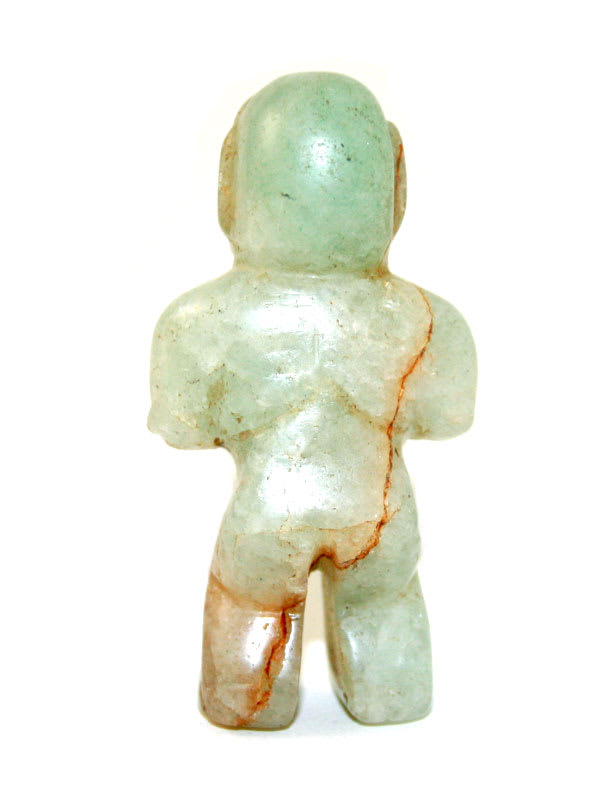Olmec Pale Green Stone Figure, 900 BCE - 500 BCE
Green Stone
2.4
DK.050 (PF.6204)
The Olmecs are generally considered to be the ultimate ancestor of all subsequent Mesoamerican civilisations. Thriving between about 1200 and 400 BC, their base was the tropical lowlands of south...
The Olmecs are generally considered to be the ultimate ancestor of all subsequent Mesoamerican civilisations. Thriving between about 1200 and 400 BC, their base was the tropical lowlands of south central Mexico, an area characterized by swamps punctuated by low hill ridges and volcanoes. Here the Olmecs practiced advanced farming techniques and constructed permanent settlements, including San Lorenzo Tenochtitlán, La Venta, Tres Zapotes, Laguna de los Cerros, and La Mojarra. However, the consolidation of their city-states led to notable cultural influence far beyond their heartland, and throughout the Mesoamerican region. This was confirmed in 2005 with the use of NAA (Neutron Activation Analysis) and petrography to demonstrate the spread of Olmec ceramic vessels. It would appear that the Olmec style became synonymous with elite status in other (predominantly highland) groups, with evidence for exchange of artefacts in both directions. A non-literate group, the Olmecs nevertheless paved the way for the development of writing systems in the loosely defined Epi- Olmec period (c. 500 BC). Further innovations include arguably the first use of the zero, so instrumental in the Maya long count vigesimal calendrical system. They also appear to have been the originators of the famous Mesoamerican ballgame so prevalent among later cultures in the region, and either retained or invented several religious symbols such as the feathered serpent and the rain spirit, which persisted in subsequent and related cultures until the middle ages.
Comparatively little is known of their magico-religious world, although the clues that we have are tantalising. The art forms for which the Olmecs are best known, the monumental stone heads weighing up to forty tons, are generally assumed to pertain to some form of kingly leader or possibly an ancestor. The smaller jade figures and celts of which this is one are believed to be domestically or institutionally based totems or divinities. The quality of production is astonishing, particularly if one considers the technology available for production, the early date of the pieces, and the dearth of earlier works upon which the Olmec sculptors could draw. Some pieces are highly stylised, while others demonstrate striking naturalism with interpretation of some facial features (notably down-turned mouths and slit eyes) that can be clearly seen in the current figure.
This miniature jade sculpture represents the other, more intimate, spectrum of Olmec art. Clearly, as the colossal heads were monuments, this work is a personal, private idol that easily fits within the palm of our hand. The odd proportions of this figure, specifically the truncated arms and bow legs, suggest that this work may represent a deformed individual such as a hunchback. Unlike Western culture that shunned such physical deformations, the Pre- Columbian civilizations of Mesoamerica heralded retardation as a blessing from the gods. Deformed persons were believed to possess heightened spiritual powers and often became shamans and spiritual leaders within the community. The facial features of this tiny sculpture are characteristic of Olmec art. The down turned mouth is a type known as the “were-jaguar,” thought by schools to depict a shaman in the midst of transmogrification. Thus, it is likely that this figurine, rendered in precious jade, was a personal idol of a deformed shaman. As great civilizations rise and fall, they leave behind traces of their existence. Ritualistic objects, venerated in their own time, continue to exert an eternal force long after they have left the hands that once held them sacred. A mysterious energy still radiates from the core of this jade carving, a testament to the artistry and culture of the ancient Olmec civilization.
Comparatively little is known of their magico-religious world, although the clues that we have are tantalising. The art forms for which the Olmecs are best known, the monumental stone heads weighing up to forty tons, are generally assumed to pertain to some form of kingly leader or possibly an ancestor. The smaller jade figures and celts of which this is one are believed to be domestically or institutionally based totems or divinities. The quality of production is astonishing, particularly if one considers the technology available for production, the early date of the pieces, and the dearth of earlier works upon which the Olmec sculptors could draw. Some pieces are highly stylised, while others demonstrate striking naturalism with interpretation of some facial features (notably down-turned mouths and slit eyes) that can be clearly seen in the current figure.
This miniature jade sculpture represents the other, more intimate, spectrum of Olmec art. Clearly, as the colossal heads were monuments, this work is a personal, private idol that easily fits within the palm of our hand. The odd proportions of this figure, specifically the truncated arms and bow legs, suggest that this work may represent a deformed individual such as a hunchback. Unlike Western culture that shunned such physical deformations, the Pre- Columbian civilizations of Mesoamerica heralded retardation as a blessing from the gods. Deformed persons were believed to possess heightened spiritual powers and often became shamans and spiritual leaders within the community. The facial features of this tiny sculpture are characteristic of Olmec art. The down turned mouth is a type known as the “were-jaguar,” thought by schools to depict a shaman in the midst of transmogrification. Thus, it is likely that this figurine, rendered in precious jade, was a personal idol of a deformed shaman. As great civilizations rise and fall, they leave behind traces of their existence. Ritualistic objects, venerated in their own time, continue to exert an eternal force long after they have left the hands that once held them sacred. A mysterious energy still radiates from the core of this jade carving, a testament to the artistry and culture of the ancient Olmec civilization.



